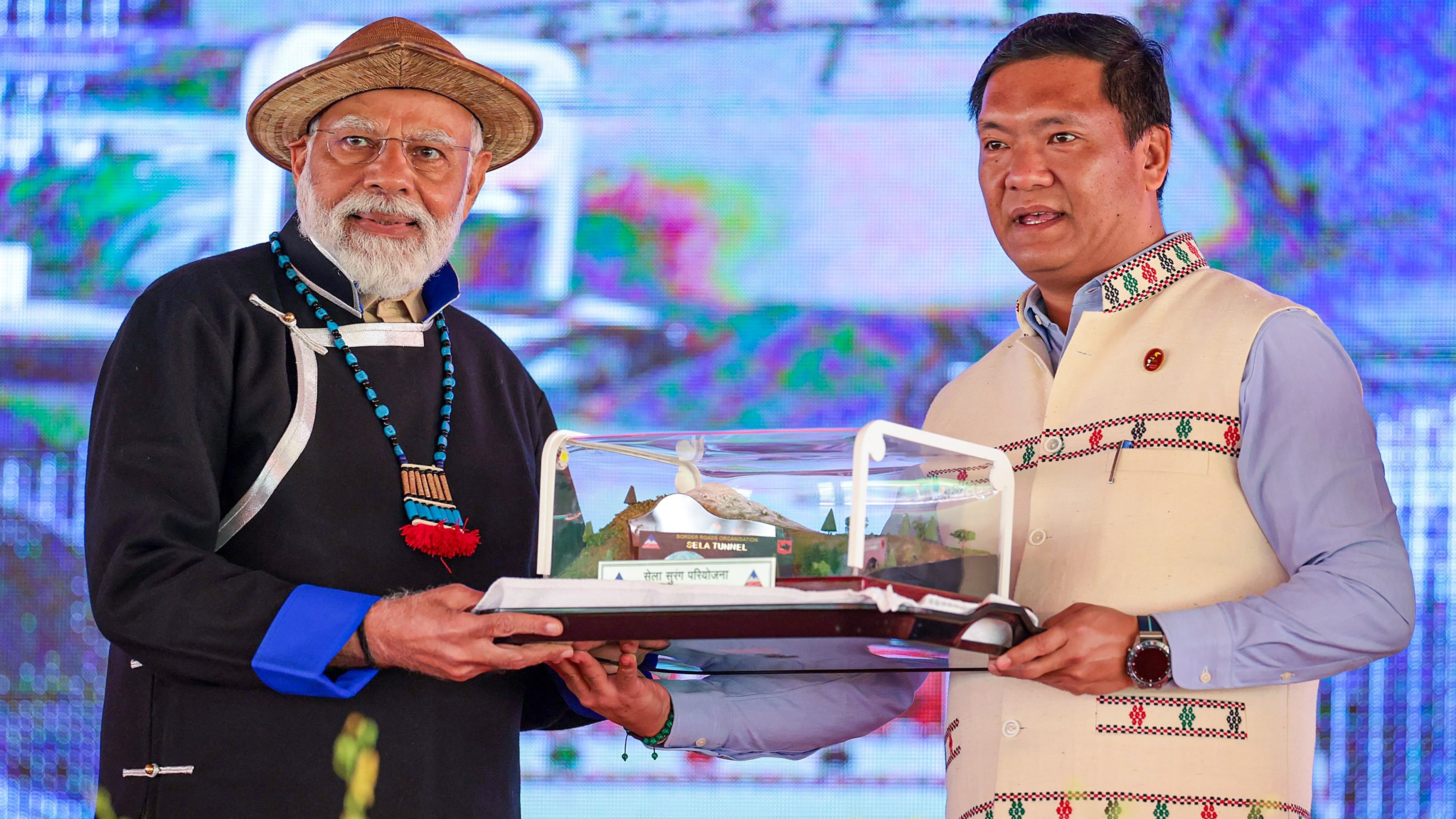
Prime Minister Narendra Modi and Arunachal Pradesh Chief Minister Pema Khandu.
Credit: PTI Photo
New Delhi: After Beijing objected to Prime Minister Narendra Modi’s recent visit to Arunachal Pradesh, New Delhi on Tuesday not only strongly rejected China’s latest bid to reassert its territorial claim but also stressed that the northeastern state was and would remain an integral part of India.
New Delhi also rejected Beijing’s bid to question India’s right to build a tunnel in Arunachal Pradesh to ensure all-weather connectivity and to facilitate faster mobilization of troops to the country’s disputed boundary with China.
“We reject the comments made by the Chinese side regarding the visit of the Prime Minister to Arunachal Pradesh. Indian leaders visit Arunachal Pradesh from time to time, as they visit other States of India,” Randhir Jaiswal, the spokesperson of the Ministry of External Affairs (MEA), said in New Delhi. “Objecting to such visits or India's developmental projects does not stand to reason,” he added.
“Further,” continued the MEA spokesperson, “it will not change the reality that the State of Arunachal Pradesh was, is, and will always be an integral and inalienable part of India. The Chinese side has been made aware of this consistent position on several occasions.”
Modi visited Itanagar – the capital of Arunachal Pradesh – on Saturday. He remotely dedicated to the nation the Sela Tunnel built at an altitude of 13,000 feet in Arunachal Pradesh. The Rs 825 crore tunnel constructed on the road connecting Tezpur in Assam with the West Kameng district of Arunachal Pradesh will provide all-weather connectivity to Tawang, which is at the core of the India-China boundary dispute in the eastern sector.
The tunnel will make it easier for the Indian Army to mobilize troops and military hardware to the McMahon Line – the de facto boundary between India and China in Arunachal Pradesh – to resist any aggressive move by the communist country’s People’s Liberation Army (PLA) in the region, like the one in 1962.
“The area of Zangnan is Chinese territory. The Chinese government has never recognized the so-called ‘Arunachal Pradesh’ illegally set up by India and firmly opposes it,” Wang Wenbin, a spokesperson of the Ministry of Foreign Affairs of the government of China, told journalists in Beijing on Monday. “The China-India boundary question has yet to be solved. India has no right to arbitrarily develop the area of Zangnan in China,” he asserted.
“India’s relevant moves will only complicate the boundary question and disrupt the situation in the border areas between the two countries. China strongly deplores and firmly opposes the Indian leader’s visit to the East Section of the China-India boundary. We have made solemn representations to India,” he added.
Beijing claims almost the entire state of – over 80000 sq. km. of area – Arunachal Pradesh of India as a part of the territory of China and calls it Zangnan or south Tibet. India claims that China is illegally occupying about 38,000 sq km of its territory in Aksai Chin, which borders eastern Ladakh. China claims nearly 2000 sq. km. of land in Himachal Pradesh and Uttarakhand of India.
The soldiers of the Indian Army and the Chinese PLA have been engaged in a military stand-off along the Line of Actual Control (LAC) in eastern Ladakh since April-May 2020. The stand-off reached a flashpoint when the soldiers of the two sides had a violent face-off on June 15, 2020, leading to casualties on both sides.
Though protracted negotiations led to the mutual withdrawal of troops by both the Indian Army and the Chinese PLA from some of the face-off points along the LAC, like Galwan Valley, the northern and southern banks of Pangong Tso, Gogra Post, and Hot Springs, the stand-off could not be resolved completely so far. The PLA troops deployed in Depsang, well inside the territory of India along the LAC with China, are still continuing to block the Indian Army’s access to Patrolling Points 10, 11, 12, 12A, and 13. A face-off is also continuing in Demchok.
There have been occasional escalations of tension in the eastern and middle sectors of the disputed boundary between the two nations, due to the Chinese PLA’s aggressive moves and quick resistance by the Indian Army.
Apart from showing the territories of India as China’s own or disputed in the official maps, Beijing has been resorting to several other ways to assert its claims on territories of India – be it by assigning Chinese and Tibetan names to areas – particularly in Arunachal Pradesh – it has been eyeing, or by issuing stapled visas to people from Arunachal Pradesh, Ladakh and Jammu and Kashmir and thus avoiding recognizing them as citizens of India.
